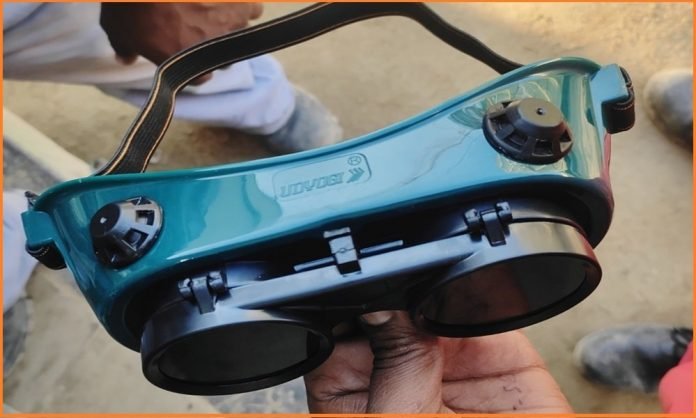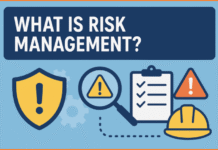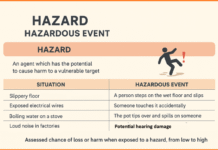Welding and gas cutting goggles are personal protective equipment designed to safeguard the eyes of workers engaged in welding, cutting, and related industrial processes. One crucial aspect of this process is understanding and utilizing the Darkness Index Number (DIN) of glass, which plays a significant role in protecting the eyes of welders or gas cutters from harmful radiation. In this article, we will discuss the fundamentals of welding and gas cutting goggles while emphasizing the importance of DIN for eye protection.
Contents
Welding and Gas Cutting:
Welding and gas cutting are essential processes in various industries, from construction to automotive, where jointing or cutting materials like metals is a common requirement. These processes involve the use of high temperature and light, which emits harmful ultraviolet (UV) and infrared (IR) radiation. When performing these tasks, it is important to safeguard the eyes against these radiations, as prolonged exposure can lead to serious eye injuries.
Darkness Index Number (DIN):
The Darkness Index Number, commonly referred to as DIN, is a standardized measure used to indicate the darkness of welding glass, filters and lenses. The DIN scale ranges from 3 to 14, with higher numbers indicating darker lenses. The purpose of the DIN is to protect the eyes by reducing the intensity of visible light, UV, and IR radiation during welding or gas cutting processes.
Choosing the Right DIN for Welding and Gas Cutting:
Selecting the appropriate DIN for a specific welding or gas cutting application is crucial to ensure the safety of the welder and gas cutter. The choice of DIN depends on factors such as the welding process, materials used, and the intensity of the radiation generated. Here are some general guidelines:
- Low DIN (DIN 3-5): Suitable for light welding processes such as oxy-fuel welding or cutting. These are also used during the setup phase or while grinding.
- Medium DIN (DIN 6-9): Ideal for general welding applications, including MIG (Metal Inert Gas) and TIG (Tungsten Inert Gas) welding. Provides a balanced level of protection against visible light and radiation.
- High DIN (DIN 10-14): Reserved for intense welding processes like arc welding or plasma cutting. Offers maximum protection against bright light and harmful radiation.
Importance of DIN in Eye Protection:
Welders and gas cutter must use the correct DIN to protect their eyes effectively. Failing to do so can result in conditions such as arc eye, a painful inflammation of the cornea caused by exposure to UV and IR radiation. Long-term exposure without proper eye protection may lead to permanent damage, including cataracts.
Safety Tips:
- Always inspect welding lenses for cracks, scratches, or other damage before use.
- Ensure that the chosen DIN is appropriate for the specific welding or gas cutting process.
- Use additional personal protective equipment, such as welding helmets, to enhance safety.
- Take regular breaks to minimize eye strain and fatigue.
Welding and gas cutting glass with the correct DIN is very important for ensuring the safety of gas cutter and welders. Understanding the Darkness Index Number and its significance in protecting against harmful radiation is essential for anyone involved in these processes. By prioritizing eye safety and following recommended guidelines, individuals can enjoy a safer working environment and reduce the risk of long-term eye damage.
Frequently Asked Questions (FAQ) for Gas Cutting and Welding Goggles/Glass with DIN (Darkness Index Number):
1. What is DIN, and why is it important in gas cutting and welding goggles?
DIN, or Darkness Index Number, is a standardized measure indicating the darkness of welding lenses or goggles. It is crucial in gas cutting and welding as it determines the level of protection against harmful radiation, ensuring the safety of the operator’s eyes.
2. How do I choose the right DIN for my gas cutting and welding activities?
The appropriate DIN depends on the specific welding or cutting process, the materials involved, and the intensity of radiation. Generally, low DINs (3-5) are suitable for light processes, while higher DINs (10-14) are reserved for intense welding or cutting.
3. Can I use the same goggles for both gas cutting and welding, or do I need separate ones?
While some goggles are versatile enough to be used for both gas cutting and welding, it’s essential to ensure they provide the appropriate level of darkness for the specific task. Some applications may require higher DINs for optimal protection.
4. Are gas cutting and welding goggles interchangeable with standard safety goggles?
Gas cutting and welding goggles are specialized for protection against intense light and radiation. While they may share some features with standard safety goggles, it’s recommended to use goggles designed explicitly for welding and cutting activities due to the specific hazards involved.
5. How often should I replace the lenses of my gas cutting and welding goggles?
Regularly inspect the lenses for any damage, scratches, or signs of wear. Replace them immediately if compromised. The frequency of replacement depends on usage and the severity of the working conditions.
6. What additional safety measures should I take when using gas cutting and welding goggles?
In addition to wearing goggles, use other personal protective equipment (PPE) such as welding helmets, gloves, and appropriate clothing. Ensure proper ventilation in the workspace to minimize fumes and maintain clear visibility.
7. Can I use gas cutting and welding goggles for tasks like grinding or other non-welding activities?
Yes, goggles with lower DINs (3-5) are suitable for tasks like grinding or other non-welding activities. However, ensure they provide adequate protection against the specific hazards associated with those tasks.
8. How do I clean and maintain my gas cutting and welding goggles?
Clean lenses regularly using a soft, clean cloth. Avoid abrasive materials that may scratch the lenses. Inspect the frames for any damage, and replace worn-out components promptly.
9. Can prolonged use of gas cutting and welding goggles lead to eye fatigue?
Extended use may cause eye fatigue. Take regular breaks, ensure proper lighting in the workspace, and consider goggles with features like adjustable straps and ventilation for enhanced comfort.





